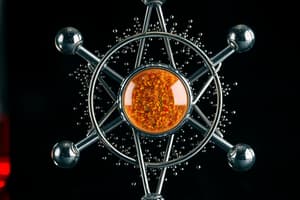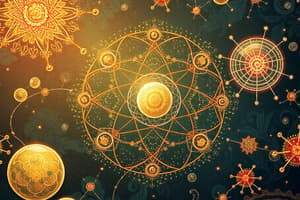Podcast
Questions and Answers
What conclusion can be drawn about the identity of atoms in an element?
What conclusion can be drawn about the identity of atoms in an element?
- Atoms in an element can change into another element.
- Atoms in an element have different sizes.
- Atoms in an element are all identical. (correct)
- Atoms in an element can vary in mass.
What does Dalton's theory imply about chemical reactions?
What does Dalton's theory imply about chemical reactions?
- Compounds can transform into single elements.
- Mass is lost during chemical reactions.
- Atoms rearrange to create new substances. (correct)
- Atoms are created and destroyed during reactions.
Which of the following is NOT a common property of metals?
Which of the following is NOT a common property of metals?
- High melting points
- Strong and malleable
- Shiny when polished
- Poor conductors of heat (correct)
Which statement is true regarding the symbols for elements?
Which statement is true regarding the symbols for elements?
What is the main characteristic of non-metal oxides?
What is the main characteristic of non-metal oxides?
Which reaction represents an example of a metal oxide formation?
Which reaction represents an example of a metal oxide formation?
What is maintained in a chemical change according to Dalton's atomic theory?
What is maintained in a chemical change according to Dalton's atomic theory?
What determines the position of elements in the modern periodic table?
What determines the position of elements in the modern periodic table?
What happens to the mass of a substance during a physical change?
What happens to the mass of a substance during a physical change?
Which of these statements about the atomic structure is incorrect?
Which of these statements about the atomic structure is incorrect?
Flashcards
Dalton's Atomic Theory
Dalton's Atomic Theory
The idea that matter is made up of tiny, indivisible particles called atoms. These atoms cannot be created or destroyed, but rather rearrange during chemical reactions.
Chemical Reaction
Chemical Reaction
A process where substances change chemically, forming new substances with different properties. Signs include color changes, gas release, solid formation, and temperature shifts.
Change of State
Change of State
A change in the physical state of a substance, such as solid, liquid, or gas. No new substance is formed, only the arrangement of particles changes.
Element Symbols
Element Symbols
Signup and view all the flashcards
Chemical Formula
Chemical Formula
Signup and view all the flashcards
Groups (Periodic Table)
Groups (Periodic Table)
Signup and view all the flashcards
Atomic Number
Atomic Number
Signup and view all the flashcards
Metal and Non-metal Oxides
Metal and Non-metal Oxides
Signup and view all the flashcards
Neutralization Reaction
Neutralization Reaction
Signup and view all the flashcards
Conductivity
Conductivity
Signup and view all the flashcards
Study Notes
Dalton's Atomic Theory
- All matter is made up of tiny particles called atoms.
- Atoms are indestructible and cannot be created or destroyed.
- Atoms of an element are identical.
- In compounds, atoms of different elements join in fixed ratios.
- Atoms rearrange during chemical reactions to form new substances.
Chemical Reactions
- Signs of a chemical reaction include color change, gas production, solid formation in solution, or temperature change.
- The mass of the reactants equals the mass of the products.
- Example: Hydrogen + Chlorine → Hydrogen Chloride
Changes of State
- Changes of state are physical changes.
- No atoms are lost or gained during a physical change.
- Mass of the substance remains the same.
Elements and Symbols
- Elements are represented by unique symbols.
- Each symbol starts with a capital letter.
- Additional letters, if needed, are lowercase.
- Examples: Nitrogen (N), Lithium (Li), Chlorine (Cl), Iron (Fe), etc.
Metals and Non-metals
- Metals: Generally high melting point, shiny, malleable, ductile, good conductors of heat and electricity.
- Non-metals: Generally low melting point, dull, brittle, poor conductors of heat and electricity.
Atoms in a Compound
- Chemical formulas show the ratio of atoms in a compound.
- Example: Water (H₂O)
Periodic Table
- Elements are organized in order of atomic number (number of protons).
- Elements in the same group have similar properties.
- Elements in the same period show trends in properties.
Metal and Non-metal Oxides
- Many metals react with oxygen to form metal oxides (e.g., calcium + oxygen → calcium oxide).
- Metal oxides usually form alkaline solutions when reacted with water.
- Non-metals react with oxygen to form nonmetal oxides (e.g., carbon + oxygen → carbon dioxide).
- Non-metal oxides usually form acidic solutions when reacted with water.
Studying That Suits You
Use AI to generate personalized quizzes and flashcards to suit your learning preferences.




